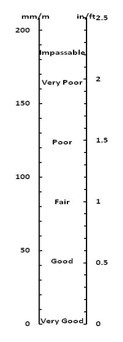Development of Surface Roughness Standards for Pathways Used by Wheelchair Users: Final Report
5. Significance and Use
5.1 This practice provides a means for obtaining a quantitative estimate of a surface property defined as roughness using longitudinal profile measuring equipment.
5.1.1 The PRI is portable in that it can be obtained from longitudinal profiles obtained with a variety of instruments.
5.1.2 The PRI is stable with time because true PRI is based on the concept of a true longitudinal profile, rather than the physical properties of a particular type of instrument.
5.2 Roughness information will be a useful input to the pathway and sidewalk management systems maintained by municipal agencies.
5.2.2 When profiles are measured simultaneously for multiple traveled wheel tracks, then the MRI is considered to be a better measure of pathway surface roughness than the PRI for either wheel individually.
5.3 Pathway roughness data will be useful when determining the vibration exposure that a wheelchair user will experience.
5.3.1 Vibration exposure has been linked to pain and injuries in wheelchair users and the PRI of traveled surfaces will provide the ability to quantify the vibration exposure a wheelchair user will experience when traveling that surface.
5.3.2 Knowledge of the vibration exposure a wheelchair user will experience on traveled surfaces will allow them to take steps to minimize their exposure, reducing the likelihood of pain and injury.
NOTE 1—The MRI scale is identical to the PRI scale.

Fig. 1: Pathway Roughness Index and Ratings

User Comments/Questions
Add Comment/Question